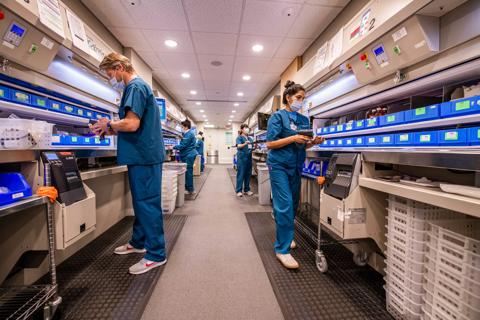Workers step outside usual roles to lighten the load for hospital colleagues

In September of 2021, a team of Cleveland Clinic operations and nursing leaders devised a plan to allow employees from anywhere in the health system to volunteer to aid those who clean patient rooms, deliver food or transport patients who have been cleared for discharge. How many people would step up to help was uncertain, but it was worth a try. COVID-19-related staffing shortages are challenging hospitals around the world, and the team knew that whatever help they could offer would be a benefit.
Cleveland Clinic is a non-profit academic medical center. Advertising on our site helps support our mission. We do not endorse non-Cleveland Clinic products or services. Policy
“We were very agile,” says Bridget Gorman, Executive Director of Hospital Operations. “We needed to do something fast, because the pandemic stress on the workforce was becoming dire.”
The efforts paid off. By the end of 2021, the Partners for Patient Care program had filled more than 200 shifts running about four hours each.
The program continues as the pandemic surge seeps into the new year, says Gorman, who worked on the project with leaders from Nursing, Food Service, Environmental Services (EVS) and Patient Transport.
“We had caregivers sign up to help with removing food trays from patient rooms, transporting patients who were getting discharged from the hospital, and helping to strip vacated patient rooms in preparation for cleaning,” Gorman says.
The functions and shifts were limited, but the contributions have made a surprising impact, she adds. “For EVS, it cut the amount of time they had to spend cleaning a room by about half,” Gorman says. “That’s pretty meaningful.”
It has made a difference for patients, too, she adds. “When Food Service is short staffed, it takes more time to pick up food trays. By dinner time, sometimes patients might have more than one tray in their room. There were many shifts where we removed more than 100 food trays from patient rooms.”
In addition to Partners for Patient Care, the health system’s Nursing Operations Department on Dec. 13 launched Support As One, which places employee volunteers on nursing units for four-hour shifts that might encompass a variety of tasks that do not require clinical licensing. As happened with the Partners program, Cleveland Clinic employees were quick to raise their hands to help.
“By three weeks in, over 140 caregivers had signed up and we had provided over 1,700 hours of support,” says Yasmine Quabili, Nursing Operations Project Manager. “Caregivers are helping with all kinds of things, like restocking materials and actually answering call lights. Maybe a patient needs another blanket. The volunteer has been oriented and knows where the blankets are, so they can easily do that, which frees up a nurse for other tasks. That non-clinical assistance may allow clinical caregivers to step away and take a breath for a minute.”
Nurses have welcomed the help, says Meredith Foxx, MSN, MBA, APRN, NEA-BC, PCNS-BC, PPCNP-BC, CPON, Executive Chief Nursing Officer.
“I am so grateful for all who are responding to the call for action,” says Foxx. “This pandemic has led to so many changes in the way we deliver health care, and has presented so many challenges. Our nursing teams are very thankful for the caregivers who have changed their work routines to assist at the point of care. Many of these helping hands caregivers have never been patient facing, and wow, have they stepped up. All caregivers have been delivering on our values of empathy, teamwork and integrity.”
With both programs, the first step was getting buy-in from leaders across the health system, who then shared details and encouraged participation. Initial efforts have involved exempt employees, who can volunteer either on their own time or, with their supervisors’ permission, during work hours. Partners for Patient Care also allows hourly workers to participate. They must clock in and out for their shift.
Shifts are posted and filled using the third-party platform SignUp Genius. Participants receive instructions for where to go and the kinds of duties they might be asked to perform, and are trained at the start of the shift. Partners for Patient Care volunteers receive T-shirts that help distinguish them during their shift. Support As One participants wear scrubs.
Both programs tend to draw participants who understand that their role is to lighten the load of licensed caregivers, so they come in ready to initiate help rather than waiting for instruction.
One of the keys to success, Quabili says, is making sure that volunteers know who to make contact with for their shift, whether that’s a specific person or simply a position. As a matter of record, those who volunteer for Support As One also are included in Cleveland Clinic’s Kronos timekeeping software, so charge nurses begin the day knowing what the workforce resources will be.
As much help as the participants of the programs provide during their shifts, they have gotten plenty back. Both Gorman and Quabili have participated, and felt gratified by the opportunity step out from behind computers and view the health system’s mission in a more direct way.
“It connects the volunteers to patient care – to why we’re here,” Gorman says. “When you walk in a patient’s room, they often want to chat with you about whatever’s going on, and it’s great to have that experience if you’re normally in a very business-oriented role.”
“I personally filled three of the shifts, and they were fun,” she adds. “I’m normally in a suit sitting behind a desk, so it was great to step in to help those caring for our patients in a meaningful way when our teams are stretched so thin and our patients need us.”
Quabili agrees. “It opens up our eyes to see what happens on a unit,” she says. “Even if it’s just for four hours, to see what the clinical caregivers go through is pretty mind boggling. I was on a unit where, at the beginning of my shift, one of the wings had two COVID-19 patients, and by the end of my four-hour shift the whole wing was COVID patients. I thought, What just happened?”
How long the programs will continue depends on how long they are needed. Both teams will continue to evaluate as the pandemic changes. Some participants have voiced an interest in keeping the strategy going, both as a way to mitigate ongoing workforce challenges and as a means to enable non-clinical employees to connect directly with patient care.

Flexibility, support and foundational skills are key

How technology is changing how and whom we hire

Experts explain importance of supporting employee growth

Friendship highlights the advantages of mentorship, coaching and collaboration

Popular management strategy helps organization define success and track results

Leaders foster retention through programs that help caregivers thrive

The investment needed to take their skills to the next level

Expert advice on attracting and hiring modern job seekers